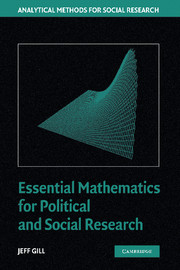Book contents
- Frontmatter
- Contents
- List of Tables
- List of Illustrations
- List of Examples
- Preface
- 1 The Basics
- 2 Analytic Geometry
- 3 Linear Algebra: Vectors, Matrices, and Operations
- 4 Linear Algebra Continued: Matrix Structure
- 5 Elementary Scalar Calculus
- 6 Additional Topics in Scalar and Vector Calculus
- 7 Probability Theory
- 8 Random Variables
- 9 Markov Chains
- References
- Author Index
- Subject Index
- Frontmatter
- Contents
- List of Tables
- List of Illustrations
- List of Examples
- Preface
- 1 The Basics
- 2 Analytic Geometry
- 3 Linear Algebra: Vectors, Matrices, and Operations
- 4 Linear Algebra Continued: Matrix Structure
- 5 Elementary Scalar Calculus
- 6 Additional Topics in Scalar and Vector Calculus
- 7 Probability Theory
- 8 Random Variables
- 9 Markov Chains
- References
- Author Index
- Subject Index
Summary
This book is intended to serve several needs. First (and perhaps foremost), it is supposed to be an introduction to mathematical principles for incoming social science graduate students. For this reason, there is a large set of examples (83 of them, at last count) drawn from various literatures including sociology, political science, anthropology, psychology, public policy, communications, and geography. Almost no example is produced from “hypothetical data.” This approach is intended not only to motivate specific mathematical principles and practices, but also to introduce the way that social science researchers use these tools. With this approach the topics presumably retain needed relevance.
The design of the book is such that this endeavor can be a semester-long adjunct to another topic like data analysis or it can support the prefresher “mathcamp” approach that is becoming increasingly popular. Second, this book can also serve as a single reference work where multiple books would ordinarily be needed. To support this function there is extensive indexing and referencing designed to make it easy to find topics. Also in support of this purpose, there are some topics that may not be suitable for course work that are deliberately included for this purpose (i.e., things like calculus on trigonometric functions and advanced linear algebra topics). Third, the format is purposely made conducive to self-study. Many of us missed or have forgotten various mathematical topics and then find we need them later.
The main purpose of the proposed work is to address an educational deficiency in the social and behavioral sciences. The undergraduate curriculum in the social sciences tends to underemphasize mathematical topics that are then required by students at the graduate level.
- Type
- Chapter
- Information
- Essential Mathematics for Political and Social Research , pp. xxi - xxviPublisher: Cambridge University PressPrint publication year: 2006

